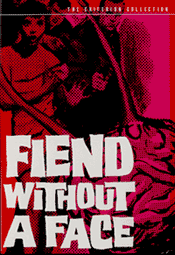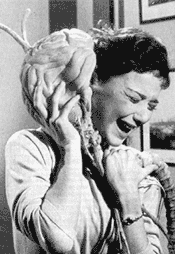The Ultimate Version of a Fan Favorite: Fiend Without a Face 
Fiend Without a Face DVD released 2001 by The Criterion Collection
1958, unrated, 74 minutes, black and white, widescreen (1.66:1 aspect ratio) enhanced for 16x9 TVs, Dolby mono sound, includes theatrical trailer, audio commentary (interview of producer Richard Gordon by Tom Weaver), illustrated text essay on British SF-horror by Bruce Eder, trailers from Gordon films, collection of stills and ephemera with commentary, advertisements and lobby cards. Suggested retail price: $39.95.
* * *
 Remember film scholars? Well, what exactly is the function of film scholars these days? Are there still jobs for them somewhere, or are they out on the streets carrying signs, “Will watch movies for food”?
Remember film scholars? Well, what exactly is the function of film scholars these days? Are there still jobs for them somewhere, or are they out on the streets carrying signs, “Will watch movies for food”?
These questions occurred to me as I spun the new Criterion Collection DVD, Fiend Without a Face. On this disk, the usual exemplary effort by Criterion, an unassuming 74 minute monster flick from the gentle 1950s is cleaned up, picked apart, probed for clues to film history and mounted in a gallery of Western cultural artifacts. For less than the cost of a month’s worth of cable TV, you can have, in a compact package, a collection of facts, trivia, analysis and imagery that would have taken a film buff years to compile, back in the bad old days. Now, everyone’s his own scholar. The DVD player is not just a movie medium. It’s a research machine. It not only shows you the film, usually in better shape than you’ll see it at a theater, but it dispenses buckets full of background, and even tells you what you’re opinion of the film should be.
Me, I don’t think Fiend Without a Face is a genre masterpiece, maybe not even the best British horror of the period. It is, however, a good monster movie, important not so much for its enduring impact but for a few significant innovations: an original mix of notions about psychic power and atomic energy, an original monster, and a grotesque climax that foreshadows splatter movies to come. Knowing that bloody finish paved the way for such epics as The Gore-Gore Girls and Friday the 13th does not reflect well on Fiend, but on its own terms, Fiend is respectable enough.
The story began as “The Thought Monster,” a moody piece of about 10 pages in the great pulp magazine Weird Tales, circa 1930, by Amelia Reynolds Long. Friend of MonsterZine Forry Ackerman, as agent for Long and other Weird Tales writers, sold the property to Richard Gordon for $400, to be adapted for film by Gordon’s new-hatched Amalgamated Productions. Screenwriter Herbert H. Leder tossed out just about everything in the story except the idea of a monster created by brain power. To this, Leder added a generous portion of 1950s SF material, including vague references to radar tests and radiation, and voila, a creature feature suitable for 1958 audiences.
The film is counted among British horrors though it’s something of a hybrid. Shot in England, it was distributed by American studio MGM, it features American actors and German special effects, it’s based on an story by an American, and it supposedly takes place on the U.S.-Canadian border—not much more British, then, than Star Wars. It’s worth noting that Fiend was distributed in a double feature with the latter-day Boris Karloff gothic The Haunted Strangler, an interesting match of two disparate films, like Amalgamated’s next double-feature venture, Karloff’s Corridors of Blood and First Man in Space.
 Marshall (Daktari) Thompson adequately fills the star role as Major Cummings, no off-color jokes please, who’s seeking a mysterious killer who deftly removes victim’s brains and spinal cords without even wrinkling their collars. The investigation is aided by the brash Barbara Griselle, portrayed by Kim Parker, who handles scientifiction dialogue and a cheesecake just-out-of-the-shower scene with equal aplomb. Then there’s Kynaston Reeves, one of those character actors you sort of recognize, as Professor Walgate, who is pretty obvious early on as the mad scientist behind it all.
Marshall (Daktari) Thompson adequately fills the star role as Major Cummings, no off-color jokes please, who’s seeking a mysterious killer who deftly removes victim’s brains and spinal cords without even wrinkling their collars. The investigation is aided by the brash Barbara Griselle, portrayed by Kim Parker, who handles scientifiction dialogue and a cheesecake just-out-of-the-shower scene with equal aplomb. Then there’s Kynaston Reeves, one of those character actors you sort of recognize, as Professor Walgate, who is pretty obvious early on as the mad scientist behind it all.
The local farm folks have a different theory. Jet noise from the local USAF base has caused a decline in milk yields, so they figure the military must be behind the killings, too. As the brain-sucked body count piles up, the shotgun-toting yokels go looking for “some mad G.I. gone wild,” or at least evidence of fallout. “We’re not exploding atomic bombs,” protests Cummings, “We’re just using atomic power for our radar experiments!” Barbara, at least, is comforted by this distinction, and bonds to the Major, to the dismay of her two-fisted boyfriend.
That sort of thing goes on for about 45 minutes, and then the movie kicks into higher gear. Suspicion falls on the professor, who is described as “a cross between Einstein and Robinson Crusoe” by the FBI, which even then had files on everyone, even lone wacko scientists, apparently. Cummings gets locked into a tomb, gratuitously. A local farmer breaks up a meeting by wandering in without a brain.
Finally, Walgate tells his story: it was an experiment to boost telekinetic power from an external source. “I needed to stimulate my brain to the extent that I could detach thought from my conscious to give it a separate entity of its own.” Or something. His technique is to run electrical current through his brain. “It made me ill,” he discovers—eureka! So he builds a Strickfaddenesque gismo to gather up “atomic power,” and with the sound of a hundred children simultaneously chewing Captain Crunch, the beasties are unleashed.
Things come to a head, so to speak, in the last 12 minutes, with the appearance of the now-visible brain critters, the antagonists in a small-scale version of The Birds, with added spurts of blood and gurgling noises. These monsters are justly famous things created by stop-motion animation. I’ve often thought stop-motion lends more personality to its subjects than other forms of FX. When used on these vicious, crafty, unnatural brain monsters, it makes them kind of cute. They crawl around in the foliage like opossums, using their spine tails for locomotion, and when they launch themselves toward their victims, they have the charming clumsiness of kung fu fighters flying on obvious wires. When one of them attempts to put out the fuse that will set off the bomb that will destroy the atomic plant control room and supposedly end the threat—well, I’m on the brain’s side, for just that moment.
Need I say that the sound and picture on this Criterion version are fine? It’s Criterion after all. The commentary and “illustrated essay” will tell you more than you need to know about the genesis, filming and finance of this “B” movie, and give you a glimpse of how movies got done in the immediate post-studio era. Criterion is a pioneer in creating collector-quality home video products, and in the creation of solid critical supplements of this kind, and the first is still the best.
